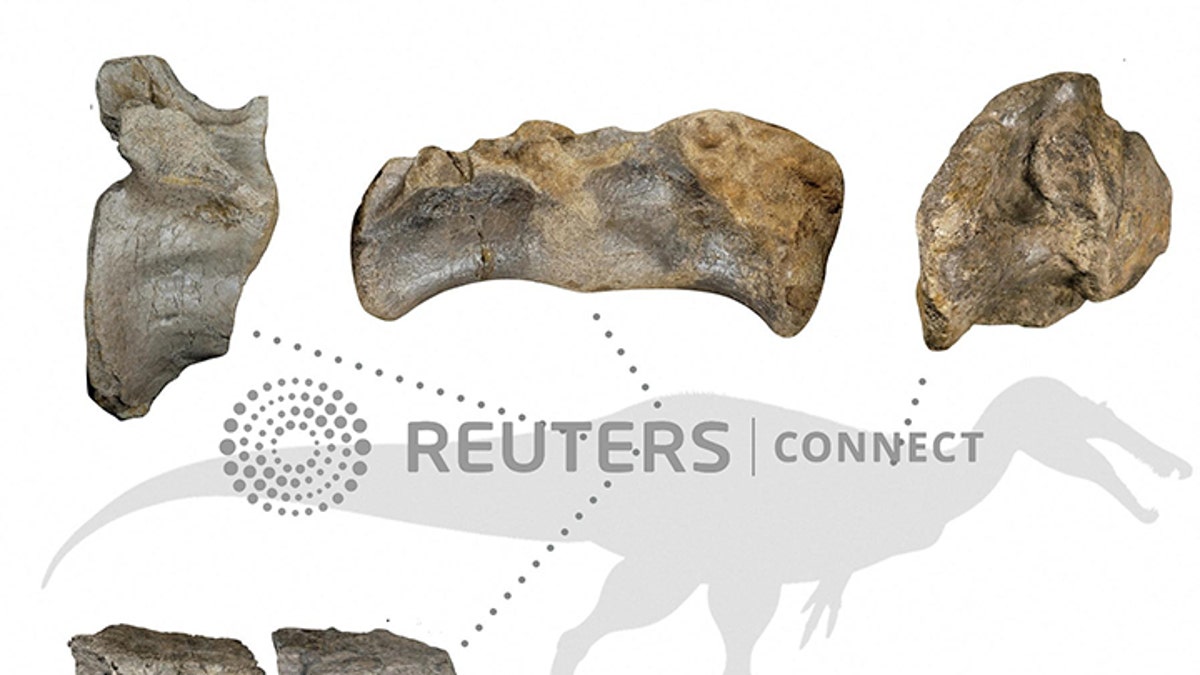'Bonecrushing' crocodile that hunted dinosaurs 230M years ago discovered in Brazil
Fossils of a 'bonecrushing' reptile that's related to the modern-day crocodile has been discovered in Brazil. The powerful scavenger that feasted on dinosaurs 230 million years ago was nicknamed the 'T. Rex of its time' by researchers.
Step aside, T. Rex.
Fossilized bones found on England’s Isle of Wight indicate there may have been an even bigger carnivorous king roaming pre-historic lands.
Paleontologists announced on Thursday that the remains of a meat-eating dinosaur may be larger than any other known in Europe and may be a cousin of the biggest carnivorous dinosaur species ever recorded, according to Reuters.
Parts of the skeleton of this dinosaur were dug up — including back, hip and tail bones and some limb fragments — they've been dated about 125 million years back during the Cretaceous Period.
SCIENTISTS CLAIM TO FIND DINOSAUR REMAINS FROM DAY OF ASTEROID STRIKE: REPORT
In an email exchange with Fox News Digital, University of Southampton paleobiologist Neil J. Gostling shared on Friday that these scattered remains lead him to believe that the massive beast measured "significantly" more than 33 feet long.
"This is a huge animal!" he exclaimed.

A diagram shows fossil remains of a meat-eating dinosaur dubbed the "White Rock spinosaurid," dating from about 125 million years ago during the Cretaceous Period. This was unearthed on England's Isle of Wight. (Barker et al/Handout via REUTERS)
"The spinosaurs that we described last year from the Wessex at the 127 million-year-old deposit … are animals which were roughly 8 to 9 m long. This animal is huge."
"The size of the specimen is impressive," University of Southampton doctoral student in paleontology Chris Barker told Reuters.
"It is one of the biggest — and possibly the biggest — known land predators ever to stalk Europe."
Experts concluded that the remains most likely belonged to a group of dinos called Spinosaurs, based on a pattern of small grooves on the top of the tail bone.
T. REX MIGHT ACTUALLY BE THREE SEPARATE SPECIES: STUDY
This group includes the dinosaur Spinosaurus, which lived about 95 million years ago and has been considered the longest-measuring predator — at about 50 feet long.
Gostling revealed that this new dinosaur "very well could" be approaching Spinosaurus size.
Spinosaurs have a makeup comparable to crocodiles, with elongated skulls and plenty of cone-shaped teeth for chomping down on slippery, aquatic prey.

An artist's illustration shows a large meat-eating dinosaur dubbed the "White Rock spinosaurid," whose remains dating from about 125 million years ago during the Cretaceous Period were unearthed on England's Isle of Wight, standing on a beach, surrounded by flying reptiles called pterosaurs. (Anthony Hutchings/Handout via REUTERS)
The newly found dinosaur has not yet been given a scientific name, since not all remains have been found — but paleontologists are calling it "White Rock spinosaurid" for the time being.
The name derives from the geological layer, the Cretaceous Vectis Formation, where the bones were uncovered.
Experts believe this dinosaur is completely unique, not belonging to any other kind of species identified before it.
This layer is an "unusual" location, since coastal environments are not known to preserve fossils well, according to Gostling.
He added, "Maybe we shouldn't be surprised that it is a spinosaur. Unlike other theropod dinosaurs, spinosaurus are known to have a closer relationship with water."
CLICK HERE TO SIGN UP FOR OUR LIFESTYLE NEWSLETTER
Experts believe this dinosaur is completely unique, not belonging to any other kind of species identified before it.
The analysis from Gostling and his team indicates the fossils might have specifically belonged to a Spinosaurine, which could mark the first Spinosaurine spinosaur in the British fossil record.
Among the meat-eating dinosaur family, also known as theropods, were some of the largest-known dinos on the continent — such as North America’s Tyrannosaurs Rex, measuring 42 feet, and Europe’s Torvosaurus, stretching about 33 feet.

A Tyrannosaurus Rex dinosaur fossil skeleton is displayed in a gallery at Christie’s auction house on Sept. 17, 2020, in New York City. (Spencer Platt/Getty Images)
The White Rock spinosaurid could be just as large as the T. Rex, Gostling told Reuters.
"Let's hope more fossils turn up," he said.
"We would love a skull or teeth."
The Isle of Wight has become a rich site for digging up dino bones.
The fossils were first spotted along Compton Bay on the Isle’s southwestern coast.
The Isle of Wight has become a rich site for digging up dino bones.
The bones were first discovered by Gostling's colleague Dr. Jeremy Lockwood and dinosaur hunter Nick Chase — who died before the pandemic, thus missing the discovery's public debut.
CLICK HERE TO GET THE FOX NEWS APP
"He would have been delighted and very pleased that Jeremy gave the material to me and Chris to look at, given what we have discovered the bones tell us," Gostling said.
Reuters contributed reporting to this article.





















